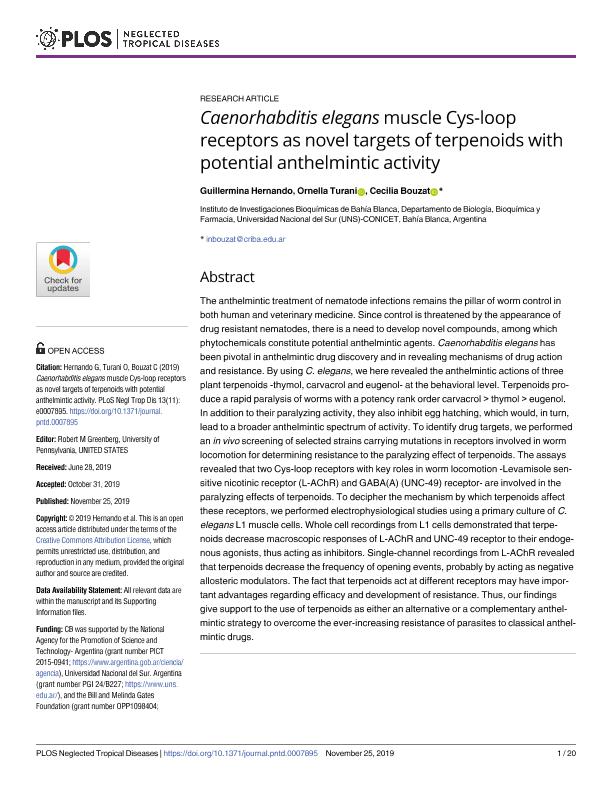Artículo
Caenorhabditis elegans muscle Cys-loop receptors as novel targets of terpenoids with potential anthelmintic activity
Fecha de publicación:
11/2019
Editorial:
Public Library of Science
Revista:
PLoS Neglected Tropical Diseases
ISSN:
1935-2735
Idioma:
Inglés
Tipo de recurso:
Artículo publicado
Clasificación temática:
Resumen
The anthelmintic treatment of nematode infections remains the pillar of worm control in both human and veterinary medicine. Since control is threatened by the appearance of drug resistant nematodes, there is a need to develop novel compounds, among which phytochemicals constitute potential anthelmintic agents. Caenorhabditis elegans has been pivotal in anthelmintic drug discovery and in revealing mechanisms of drug action and resistance. By using C. elegans, we here revealed the anthelmintic actions of three plant terpenoids -thymol, carvacrol and eugenol- at the behavioral level. Terpenoids produce a rapid paralysis of worms with a potency rank order carvacrol > thymol > eugenol. In addition to their paralyzing activity, they also inhibit egg hatching, which would, in turn, lead to a broader anthelmintic spectrum of activity. To identify drug targets, we performed an in vivo screening of selected strains carrying mutations in receptors involved in worm locomotion for determining resistance to the paralyzing effect of terpenoids. The assays revealed that two Cys-loop receptors with key roles in worm locomotion -Levamisole sensitive nicotinic receptor (L-AChR) and GABA(A) (UNC-49) receptor- are involved in the paralyzing effects of terpenoids. To decipher the mechanism by which terpenoids affect these receptors, we performed electrophysiological studies using a primary culture of C. elegans L1 muscle cells. Whole cell recordings from L1 cells demonstrated that terpenoids decrease macroscopic responses of L-AChR and UNC-49 receptor to their endogenous agonists, thus acting as inhibitors. Single-channel recordings from L-AChR revealed that terpenoids decrease the frequency of opening events, probably by acting as negative allosteric modulators. The fact that terpenoids act at different receptors may have important advantages regarding efficacy and development of resistance. Thus, our findings give support to the use of terpenoids as either an alternative or a complementary anthelmintic strategy to overcome the ever-increasing resistance of parasites to classical anthelmintic drugs.
Palabras clave:
TERPENOIDS
,
CYS-LOOP RECEPTORS
,
ANTHELMINTIC ACTIVITY
Archivos asociados
Licencia
Identificadores
Colecciones
Articulos(INIBIBB)
Articulos de INST.DE INVEST.BIOQUIMICAS BAHIA BLANCA (I)
Articulos de INST.DE INVEST.BIOQUIMICAS BAHIA BLANCA (I)
Citación
Hernando, Guillermina Silvana; Turani, Ornella; Bouzat, Cecilia Beatriz; Caenorhabditis elegans muscle Cys-loop receptors as novel targets of terpenoids with potential anthelmintic activity; Public Library of Science; PLoS Neglected Tropical Diseases; 13; 11; 11-2019
Compartir
Altmétricas




